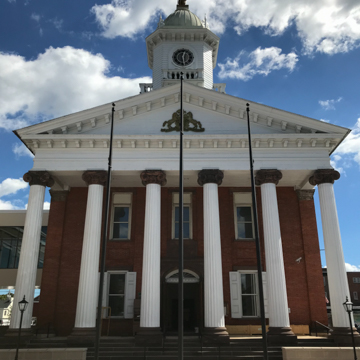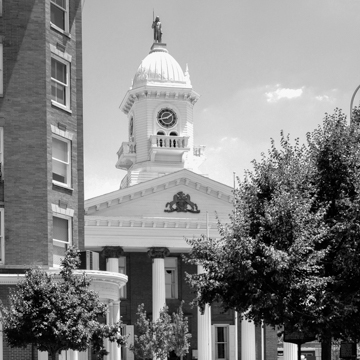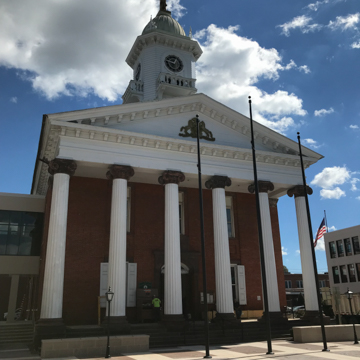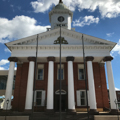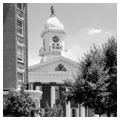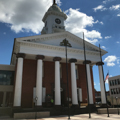The focus of the square is the courthouse's porticoed front that is capped by a square tower with a small dome on which stands the gilded figure of county namesake Benjamin Franklin firmly clasping his invention, a lightning rod in his right hand. The building's classical portico and cupola followed the model of John Haviland's demolished York County Courthouse (see YO12). Unlike the York model, this courthouse was built of brick with brownstone columns and trim, marking the shift toward the warmer hues of the late nineteenth century. The persistent tide of Colonial Revival has resulted in the columns, pediment, and cupola being painted white, misleading the eye and the mind away from its period of construction.
A brownstone plaque above the main entrance details the building's history, including its destruction during the burning of Chambersburg in 1864 and its rebuilding after the Civil War ended. The county was faced with a more daunting task than the word “rebuilt” on the plaque suggests, as did the final cost of $52,000. The building originally had porticos at both ends. Apparently there were sufficient elements from the foundations, walls, and columns to reconstruct. The architectural firm responsible for the design of the new courthouse was Sloan and Hutton of Philadelphia. Samuel Sloan, alone or with partners, designed seven other courthouses in Pennsylvania between 1849 and 1869. The tower on this courthouse bears a relationship with that of five of the others.
Sloan was in the forefront nationally in the 1850s in the use and promotion of terra-cotta as architectural ornament. The 1843 stone Ionic capitals on the portico of the Franklin County Courthouse were substantially damaged, and were replaced in the rebuilding by terra-cotta ones. These beautifully detailed, but little noticed, capitals are remarkable and relatively rare survivors of the first phase of American terra-cotta, which lasted from 1849 to the Civil War. Sloan frequently collaborated with Philadelphia entrepreneur Samuel Aden Harrison, who was an agent for the first American terra-cotta manufacturer in Worcester, Massachusetts, then became a partner in a Philadelphia works. Harrison was paid for the terra-cotta chimney caps (no longer extant) on this courthouse, and he undoubtedly supplied the capitals as well. The salvaged courthouse columns, originally smooth, were “cemented” to create fluting.
The courthouse was enlarged, and the interior was remodeled, in 1902–1903 by York architect John A. Dempwolf.


